Entrepreneurship Report: Pakistani Ventures, Skills, and Economy
VerifiedAdded on 2021/09/27
|30
|11411
|95
Report
AI Summary
This comprehensive report delves into the multifaceted world of entrepreneurship, exploring various types of ventures, from small businesses to scalable startups and social enterprises. It examines the pros and cons of entrepreneurship, analyzes the skills and traits essential for success, and provides a detailed comparison between managers and entrepreneurs. The report features case studies of Pakistani food businesses like Haleem Ghar and Savour Foods, illustrating local entrepreneurial endeavors. Furthermore, it discusses the challenges faced by new startups, the influence of entrepreneurs on a country's economy, and includes analyses of both successful and failed local and international entrepreneurs. The report also explores business resources, leadership models, and the critical factors influencing entrepreneurial success, culminating in a discussion of entrepreneurship's impact on Pakistan's economy.
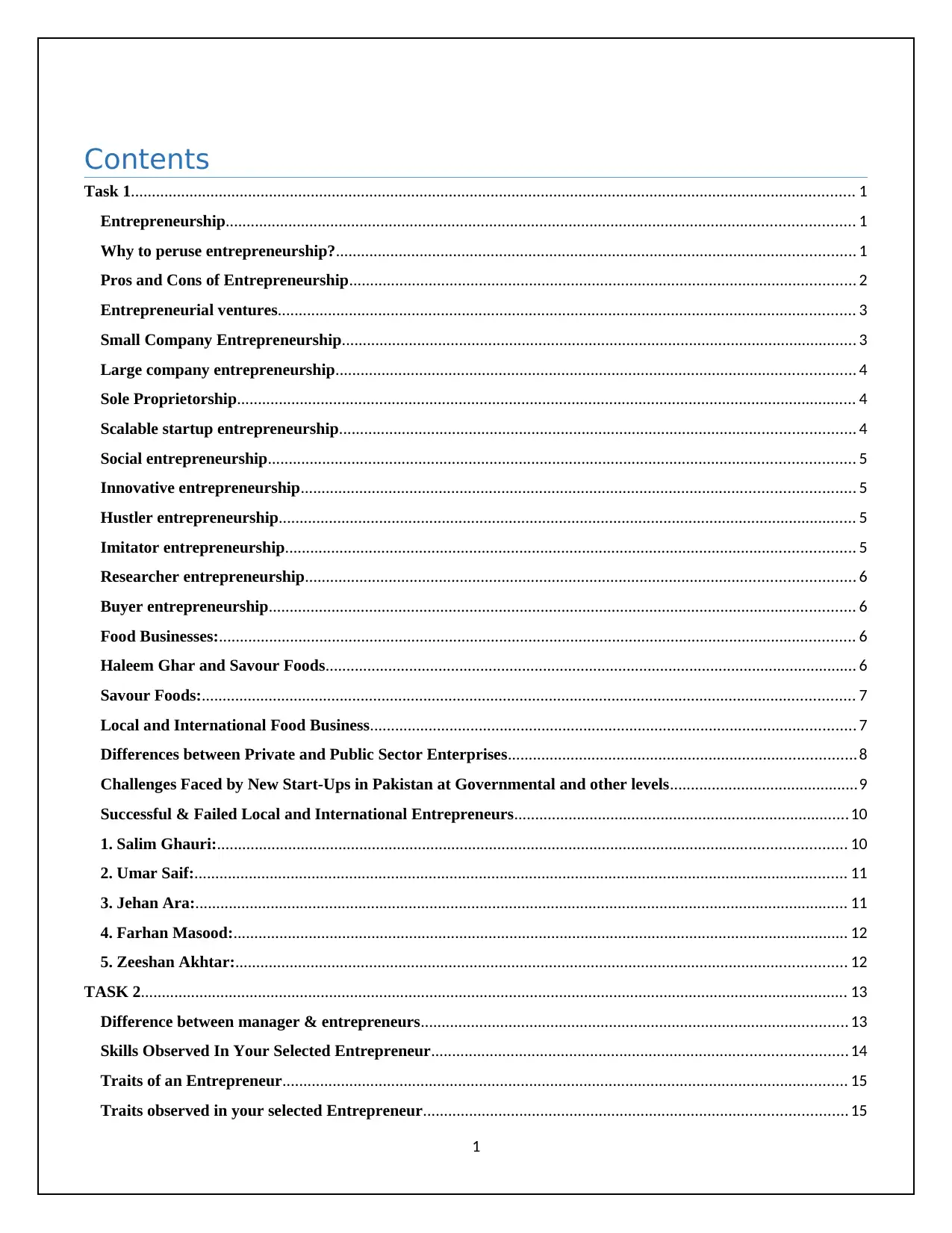
Contents
Task 1............................................................................................................................................................................. 1
Entrepreneurship...................................................................................................................................................... 1
Why to peruse entrepreneurship?............................................................................................................................ 1
Pros and Cons of Entrepreneurship......................................................................................................................... 2
Entrepreneurial ventures.......................................................................................................................................... 3
Small Company Entrepreneurship........................................................................................................................... 3
Large company entrepreneurship............................................................................................................................ 4
Sole Proprietorship.................................................................................................................................................... 4
Scalable startup entrepreneurship........................................................................................................................... 4
Social entrepreneurship............................................................................................................................................ 5
Innovative entrepreneurship.................................................................................................................................... 5
Hustler entrepreneurship.......................................................................................................................................... 5
Imitator entrepreneurship........................................................................................................................................ 5
Researcher entrepreneurship................................................................................................................................... 6
Buyer entrepreneurship............................................................................................................................................ 6
Food Businesses:........................................................................................................................................................ 6
Haleem Ghar and Savour Foods............................................................................................................................... 6
Savour Foods:............................................................................................................................................................ 7
Local and International Food Business.................................................................................................................... 7
Differences between Private and Public Sector Enterprises...................................................................................8
Challenges Faced by New Start-Ups in Pakistan at Governmental and other levels.............................................9
Successful & Failed Local and International Entrepreneurs................................................................................ 10
1. Salim Ghauri:...................................................................................................................................................... 10
2. Umar Saif:............................................................................................................................................................ 11
3. Jehan Ara:............................................................................................................................................................ 11
4. Farhan Masood:................................................................................................................................................... 12
5. Zeeshan Akhtar:.................................................................................................................................................. 12
TASK 2......................................................................................................................................................................... 13
Difference between manager & entrepreneurs...................................................................................................... 13
Skills Observed In Your Selected Entrepreneur................................................................................................... 14
Traits of an Entrepreneur....................................................................................................................................... 15
Traits observed in your selected Entrepreneur..................................................................................................... 15
1
Task 1............................................................................................................................................................................. 1
Entrepreneurship...................................................................................................................................................... 1
Why to peruse entrepreneurship?............................................................................................................................ 1
Pros and Cons of Entrepreneurship......................................................................................................................... 2
Entrepreneurial ventures.......................................................................................................................................... 3
Small Company Entrepreneurship........................................................................................................................... 3
Large company entrepreneurship............................................................................................................................ 4
Sole Proprietorship.................................................................................................................................................... 4
Scalable startup entrepreneurship........................................................................................................................... 4
Social entrepreneurship............................................................................................................................................ 5
Innovative entrepreneurship.................................................................................................................................... 5
Hustler entrepreneurship.......................................................................................................................................... 5
Imitator entrepreneurship........................................................................................................................................ 5
Researcher entrepreneurship................................................................................................................................... 6
Buyer entrepreneurship............................................................................................................................................ 6
Food Businesses:........................................................................................................................................................ 6
Haleem Ghar and Savour Foods............................................................................................................................... 6
Savour Foods:............................................................................................................................................................ 7
Local and International Food Business.................................................................................................................... 7
Differences between Private and Public Sector Enterprises...................................................................................8
Challenges Faced by New Start-Ups in Pakistan at Governmental and other levels.............................................9
Successful & Failed Local and International Entrepreneurs................................................................................ 10
1. Salim Ghauri:...................................................................................................................................................... 10
2. Umar Saif:............................................................................................................................................................ 11
3. Jehan Ara:............................................................................................................................................................ 11
4. Farhan Masood:................................................................................................................................................... 12
5. Zeeshan Akhtar:.................................................................................................................................................. 12
TASK 2......................................................................................................................................................................... 13
Difference between manager & entrepreneurs...................................................................................................... 13
Skills Observed In Your Selected Entrepreneur................................................................................................... 14
Traits of an Entrepreneur....................................................................................................................................... 15
Traits observed in your selected Entrepreneur..................................................................................................... 15
1
Paraphrase This Document
Need a fresh take? Get an instant paraphrase of this document with our AI Paraphraser
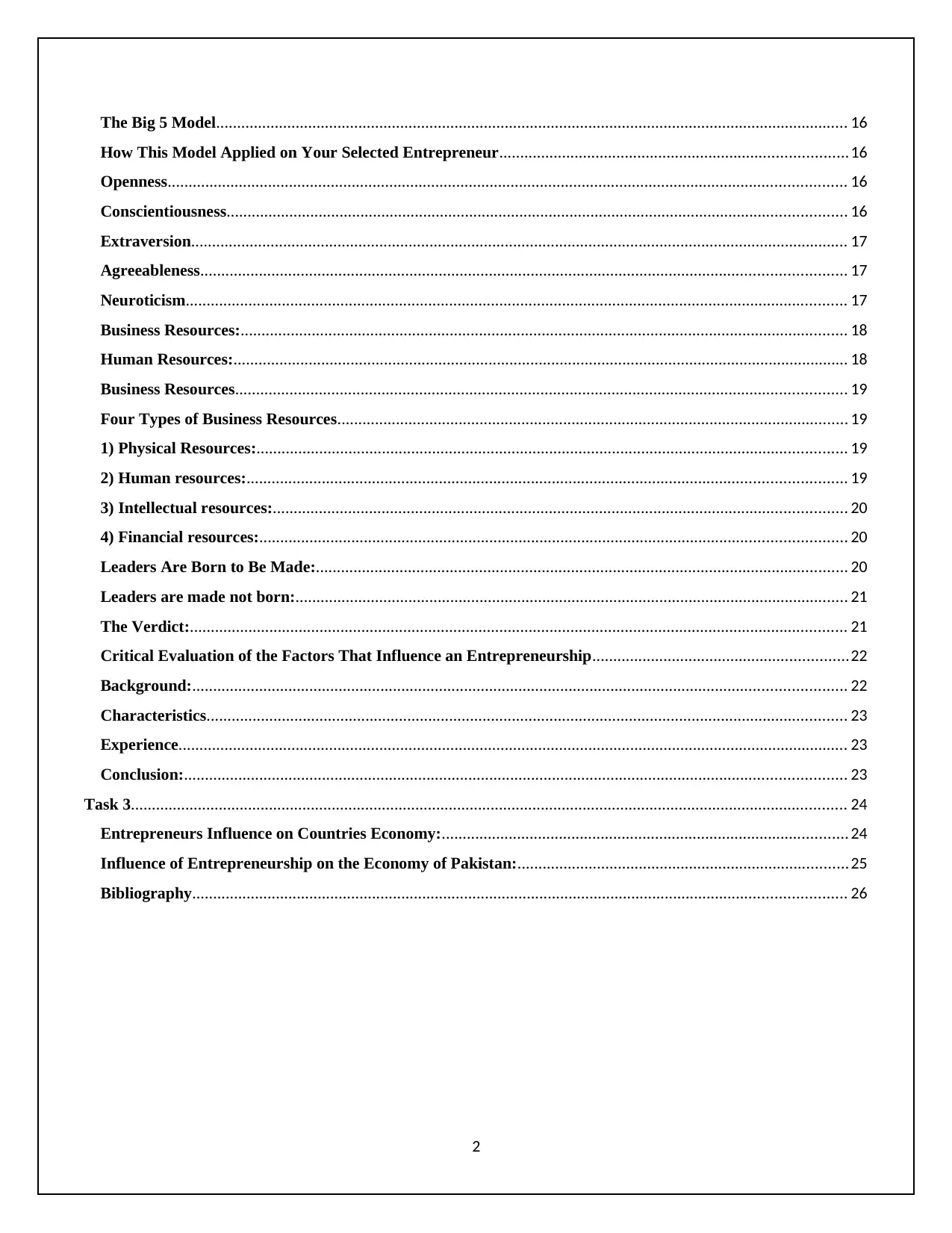
The Big 5 Model....................................................................................................................................................... 16
How This Model Applied on Your Selected Entrepreneur...................................................................................16
Openness.................................................................................................................................................................. 16
Conscientiousness.................................................................................................................................................... 16
Extraversion............................................................................................................................................................. 17
Agreeableness.......................................................................................................................................................... 17
Neuroticism.............................................................................................................................................................. 17
Business Resources:................................................................................................................................................. 18
Human Resources:................................................................................................................................................... 18
Business Resources.................................................................................................................................................. 19
Four Types of Business Resources.......................................................................................................................... 19
1) Physical Resources:............................................................................................................................................. 19
2) Human resources:............................................................................................................................................... 19
3) Intellectual resources:......................................................................................................................................... 20
4) Financial resources:............................................................................................................................................ 20
Leaders Are Born to Be Made:............................................................................................................................... 20
Leaders are made not born:.................................................................................................................................... 21
The Verdict:............................................................................................................................................................. 21
Critical Evaluation of the Factors That Influence an Entrepreneurship.............................................................22
Background:............................................................................................................................................................ 22
Characteristics......................................................................................................................................................... 23
Experience................................................................................................................................................................ 23
Conclusion:.............................................................................................................................................................. 23
Task 3........................................................................................................................................................................... 24
Entrepreneurs Influence on Countries Economy:................................................................................................. 24
Influence of Entrepreneurship on the Economy of Pakistan:...............................................................................25
Bibliography............................................................................................................................................................ 26
2
How This Model Applied on Your Selected Entrepreneur...................................................................................16
Openness.................................................................................................................................................................. 16
Conscientiousness.................................................................................................................................................... 16
Extraversion............................................................................................................................................................. 17
Agreeableness.......................................................................................................................................................... 17
Neuroticism.............................................................................................................................................................. 17
Business Resources:................................................................................................................................................. 18
Human Resources:................................................................................................................................................... 18
Business Resources.................................................................................................................................................. 19
Four Types of Business Resources.......................................................................................................................... 19
1) Physical Resources:............................................................................................................................................. 19
2) Human resources:............................................................................................................................................... 19
3) Intellectual resources:......................................................................................................................................... 20
4) Financial resources:............................................................................................................................................ 20
Leaders Are Born to Be Made:............................................................................................................................... 20
Leaders are made not born:.................................................................................................................................... 21
The Verdict:............................................................................................................................................................. 21
Critical Evaluation of the Factors That Influence an Entrepreneurship.............................................................22
Background:............................................................................................................................................................ 22
Characteristics......................................................................................................................................................... 23
Experience................................................................................................................................................................ 23
Conclusion:.............................................................................................................................................................. 23
Task 3........................................................................................................................................................................... 24
Entrepreneurs Influence on Countries Economy:................................................................................................. 24
Influence of Entrepreneurship on the Economy of Pakistan:...............................................................................25
Bibliography............................................................................................................................................................ 26
2
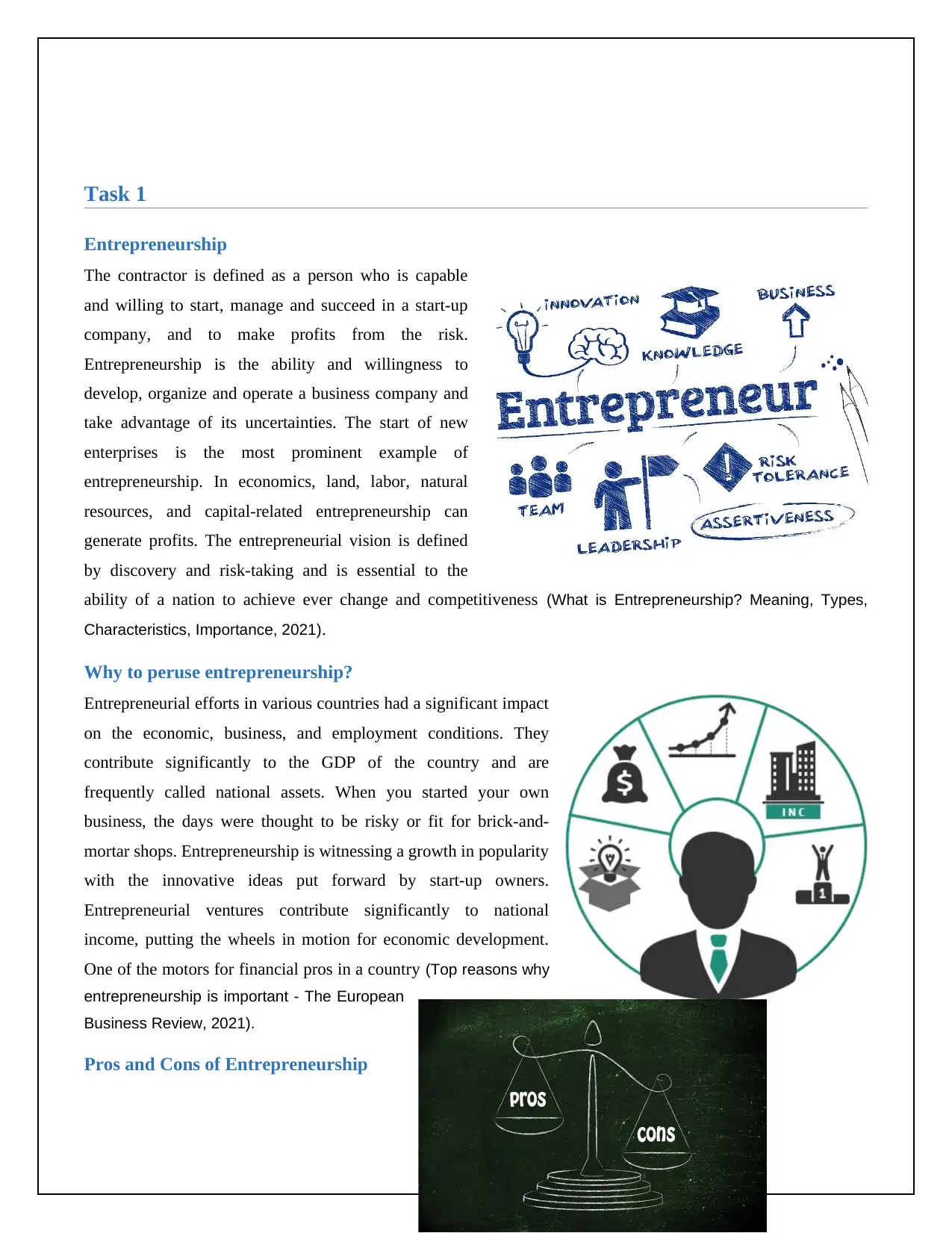
Task 1
Entrepreneurship
The contractor is defined as a person who is capable
and willing to start, manage and succeed in a start-up
company, and to make profits from the risk.
Entrepreneurship is the ability and willingness to
develop, organize and operate a business company and
take advantage of its uncertainties. The start of new
enterprises is the most prominent example of
entrepreneurship. In economics, land, labor, natural
resources, and capital-related entrepreneurship can
generate profits. The entrepreneurial vision is defined
by discovery and risk-taking and is essential to the
ability of a nation to achieve ever change and competitiveness (What is Entrepreneurship? Meaning, Types,
Characteristics, Importance, 2021).
Why to peruse entrepreneurship?
Entrepreneurial efforts in various countries had a significant impact
on the economic, business, and employment conditions. They
contribute significantly to the GDP of the country and are
frequently called national assets. When you started your own
business, the days were thought to be risky or fit for brick-and-
mortar shops. Entrepreneurship is witnessing a growth in popularity
with the innovative ideas put forward by start-up owners.
Entrepreneurial ventures contribute significantly to national
income, putting the wheels in motion for economic development.
One of the motors for financial pros in a country (Top reasons why
entrepreneurship is important - The European
Business Review, 2021).
Pros and Cons of Entrepreneurship
3
Entrepreneurship
The contractor is defined as a person who is capable
and willing to start, manage and succeed in a start-up
company, and to make profits from the risk.
Entrepreneurship is the ability and willingness to
develop, organize and operate a business company and
take advantage of its uncertainties. The start of new
enterprises is the most prominent example of
entrepreneurship. In economics, land, labor, natural
resources, and capital-related entrepreneurship can
generate profits. The entrepreneurial vision is defined
by discovery and risk-taking and is essential to the
ability of a nation to achieve ever change and competitiveness (What is Entrepreneurship? Meaning, Types,
Characteristics, Importance, 2021).
Why to peruse entrepreneurship?
Entrepreneurial efforts in various countries had a significant impact
on the economic, business, and employment conditions. They
contribute significantly to the GDP of the country and are
frequently called national assets. When you started your own
business, the days were thought to be risky or fit for brick-and-
mortar shops. Entrepreneurship is witnessing a growth in popularity
with the innovative ideas put forward by start-up owners.
Entrepreneurial ventures contribute significantly to national
income, putting the wheels in motion for economic development.
One of the motors for financial pros in a country (Top reasons why
entrepreneurship is important - The European
Business Review, 2021).
Pros and Cons of Entrepreneurship
3
⊘ This is a preview!⊘
Do you want full access?
Subscribe today to unlock all pages.

Trusted by 1+ million students worldwide
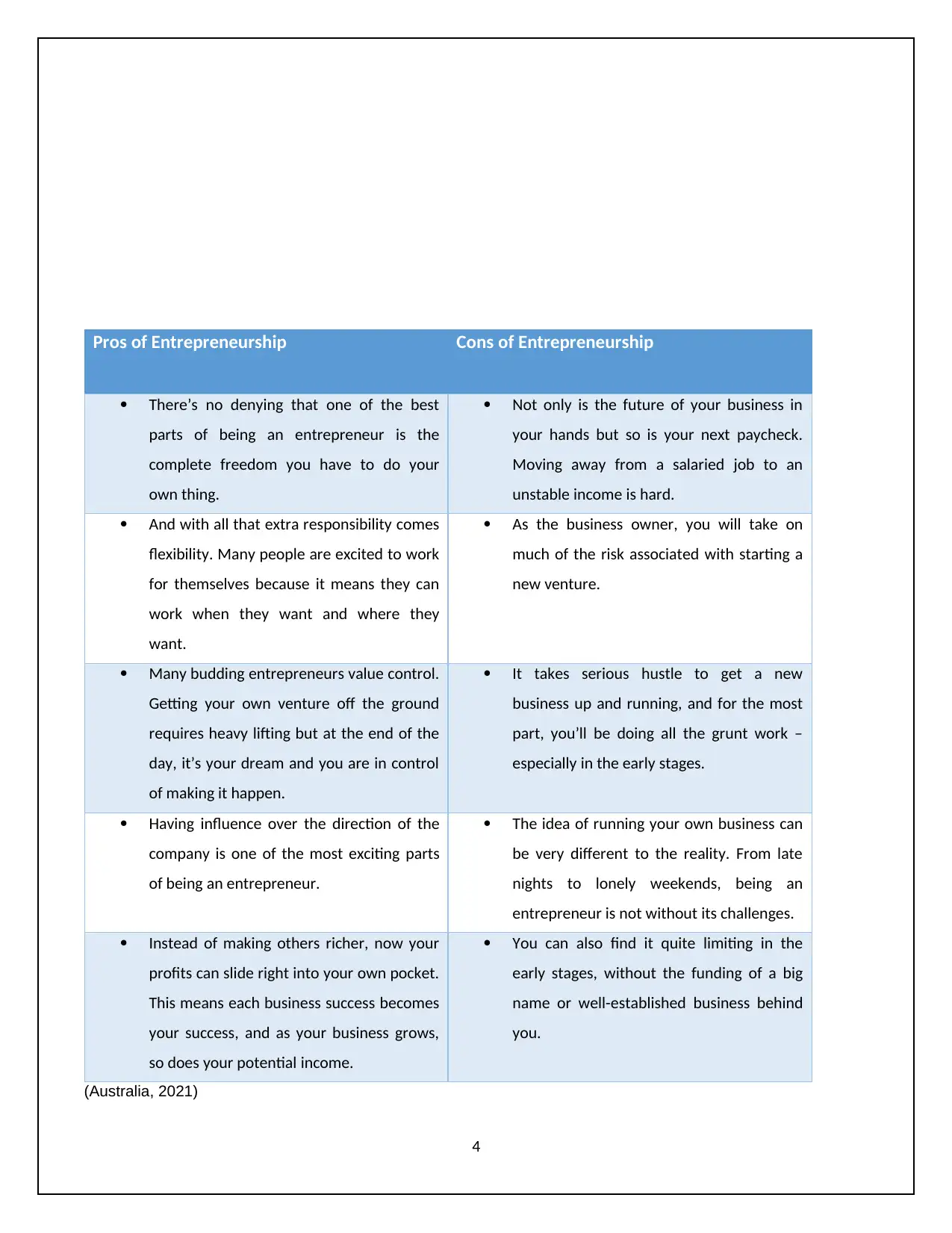
Pros of Entrepreneurship Cons of Entrepreneurship
There’s no denying that one of the best
parts of being an entrepreneur is the
complete freedom you have to do your
own thing.
Not only is the future of your business in
your hands but so is your next paycheck.
Moving away from a salaried job to an
unstable income is hard.
And with all that extra responsibility comes
flexibility. Many people are excited to work
for themselves because it means they can
work when they want and where they
want.
As the business owner, you will take on
much of the risk associated with starting a
new venture.
Many budding entrepreneurs value control.
Getting your own venture off the ground
requires heavy lifting but at the end of the
day, it’s your dream and you are in control
of making it happen.
It takes serious hustle to get a new
business up and running, and for the most
part, you’ll be doing all the grunt work –
especially in the early stages.
Having influence over the direction of the
company is one of the most exciting parts
of being an entrepreneur.
The idea of running your own business can
be very different to the reality. From late
nights to lonely weekends, being an
entrepreneur is not without its challenges.
Instead of making others richer, now your
profits can slide right into your own pocket.
This means each business success becomes
your success, and as your business grows,
so does your potential income.
You can also find it quite limiting in the
early stages, without the funding of a big
name or well-established business behind
you.
(Australia, 2021)
4
There’s no denying that one of the best
parts of being an entrepreneur is the
complete freedom you have to do your
own thing.
Not only is the future of your business in
your hands but so is your next paycheck.
Moving away from a salaried job to an
unstable income is hard.
And with all that extra responsibility comes
flexibility. Many people are excited to work
for themselves because it means they can
work when they want and where they
want.
As the business owner, you will take on
much of the risk associated with starting a
new venture.
Many budding entrepreneurs value control.
Getting your own venture off the ground
requires heavy lifting but at the end of the
day, it’s your dream and you are in control
of making it happen.
It takes serious hustle to get a new
business up and running, and for the most
part, you’ll be doing all the grunt work –
especially in the early stages.
Having influence over the direction of the
company is one of the most exciting parts
of being an entrepreneur.
The idea of running your own business can
be very different to the reality. From late
nights to lonely weekends, being an
entrepreneur is not without its challenges.
Instead of making others richer, now your
profits can slide right into your own pocket.
This means each business success becomes
your success, and as your business grows,
so does your potential income.
You can also find it quite limiting in the
early stages, without the funding of a big
name or well-established business behind
you.
(Australia, 2021)
4
Paraphrase This Document
Need a fresh take? Get an instant paraphrase of this document with our AI Paraphraser
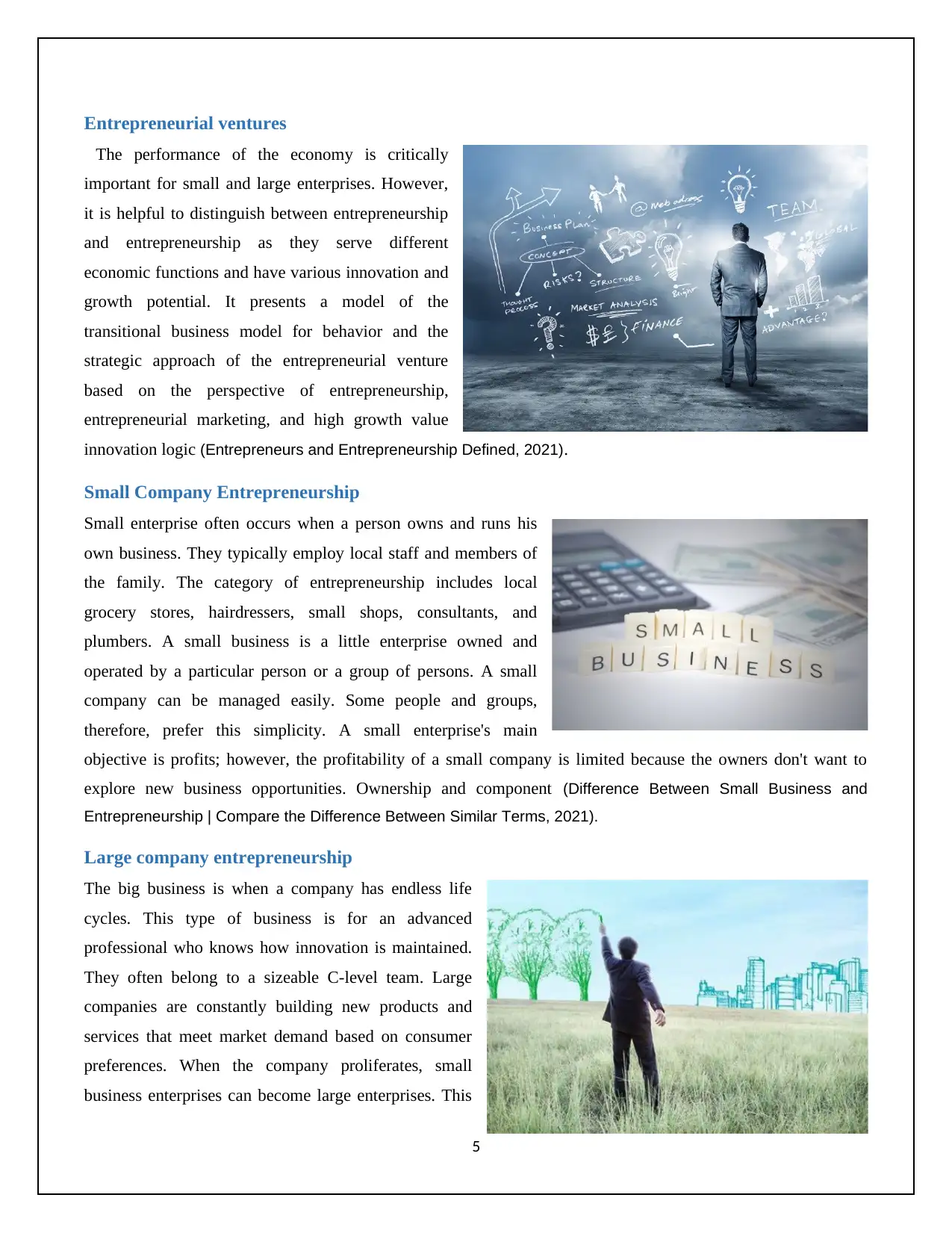
Entrepreneurial ventures
The performance of the economy is critically
important for small and large enterprises. However,
it is helpful to distinguish between entrepreneurship
and entrepreneurship as they serve different
economic functions and have various innovation and
growth potential. It presents a model of the
transitional business model for behavior and the
strategic approach of the entrepreneurial venture
based on the perspective of entrepreneurship,
entrepreneurial marketing, and high growth value
innovation logic (Entrepreneurs and Entrepreneurship Defined, 2021).
Small Company Entrepreneurship
Small enterprise often occurs when a person owns and runs his
own business. They typically employ local staff and members of
the family. The category of entrepreneurship includes local
grocery stores, hairdressers, small shops, consultants, and
plumbers. A small business is a little enterprise owned and
operated by a particular person or a group of persons. A small
company can be managed easily. Some people and groups,
therefore, prefer this simplicity. A small enterprise's main
objective is profits; however, the profitability of a small company is limited because the owners don't want to
explore new business opportunities. Ownership and component (Difference Between Small Business and
Entrepreneurship | Compare the Difference Between Similar Terms, 2021).
Large company entrepreneurship
The big business is when a company has endless life
cycles. This type of business is for an advanced
professional who knows how innovation is maintained.
They often belong to a sizeable C-level team. Large
companies are constantly building new products and
services that meet market demand based on consumer
preferences. When the company proliferates, small
business enterprises can become large enterprises. This
5
The performance of the economy is critically
important for small and large enterprises. However,
it is helpful to distinguish between entrepreneurship
and entrepreneurship as they serve different
economic functions and have various innovation and
growth potential. It presents a model of the
transitional business model for behavior and the
strategic approach of the entrepreneurial venture
based on the perspective of entrepreneurship,
entrepreneurial marketing, and high growth value
innovation logic (Entrepreneurs and Entrepreneurship Defined, 2021).
Small Company Entrepreneurship
Small enterprise often occurs when a person owns and runs his
own business. They typically employ local staff and members of
the family. The category of entrepreneurship includes local
grocery stores, hairdressers, small shops, consultants, and
plumbers. A small business is a little enterprise owned and
operated by a particular person or a group of persons. A small
company can be managed easily. Some people and groups,
therefore, prefer this simplicity. A small enterprise's main
objective is profits; however, the profitability of a small company is limited because the owners don't want to
explore new business opportunities. Ownership and component (Difference Between Small Business and
Entrepreneurship | Compare the Difference Between Similar Terms, 2021).
Large company entrepreneurship
The big business is when a company has endless life
cycles. This type of business is for an advanced
professional who knows how innovation is maintained.
They often belong to a sizeable C-level team. Large
companies are constantly building new products and
services that meet market demand based on consumer
preferences. When the company proliferates, small
business enterprises can become large enterprises. This
5
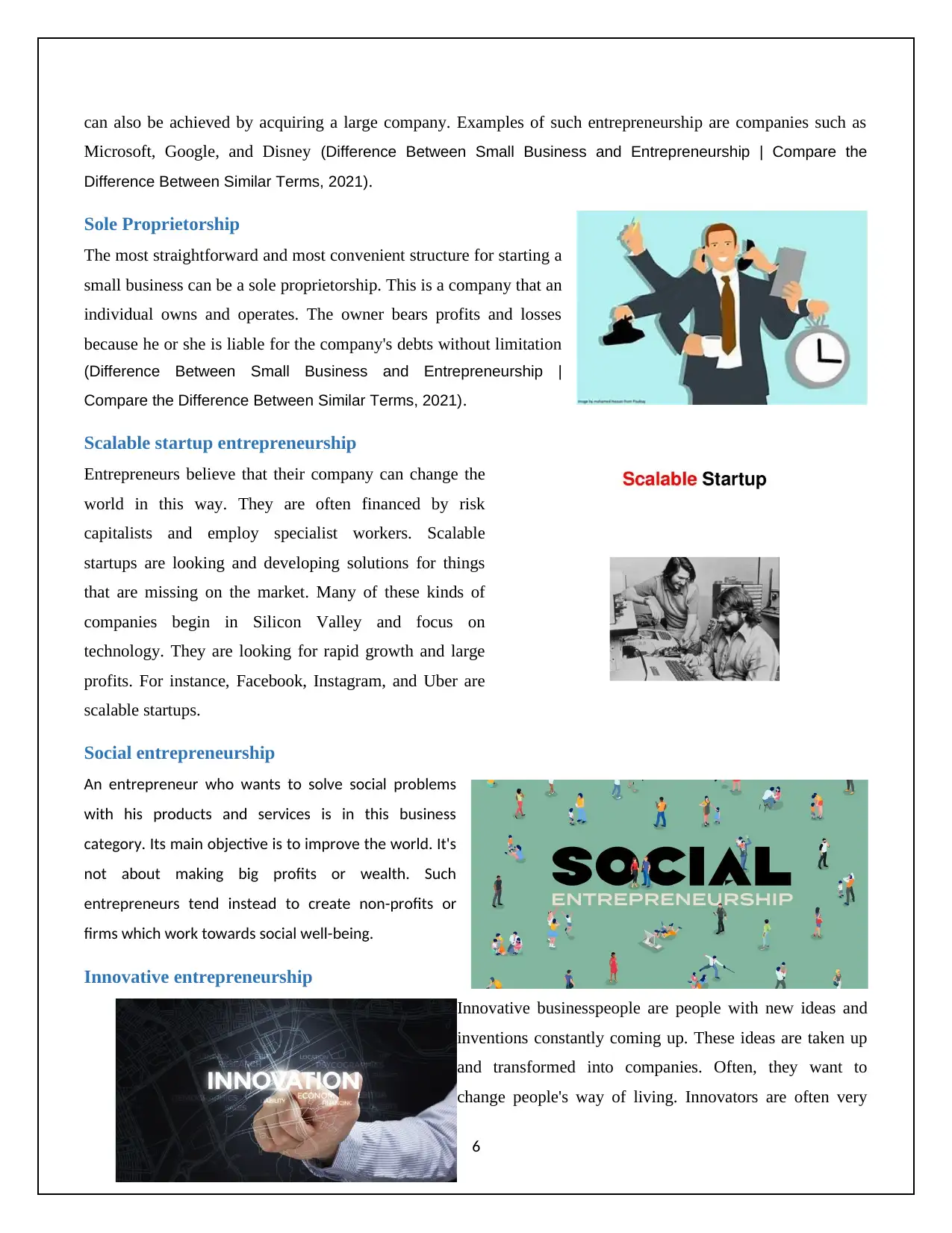
can also be achieved by acquiring a large company. Examples of such entrepreneurship are companies such as
Microsoft, Google, and Disney (Difference Between Small Business and Entrepreneurship | Compare the
Difference Between Similar Terms, 2021).
Sole Proprietorship
The most straightforward and most convenient structure for starting a
small business can be a sole proprietorship. This is a company that an
individual owns and operates. The owner bears profits and losses
because he or she is liable for the company's debts without limitation
(Difference Between Small Business and Entrepreneurship |
Compare the Difference Between Similar Terms, 2021).
Scalable startup entrepreneurship
Entrepreneurs believe that their company can change the
world in this way. They are often financed by risk
capitalists and employ specialist workers. Scalable
startups are looking and developing solutions for things
that are missing on the market. Many of these kinds of
companies begin in Silicon Valley and focus on
technology. They are looking for rapid growth and large
profits. For instance, Facebook, Instagram, and Uber are
scalable startups.
Social entrepreneurship
An entrepreneur who wants to solve social problems
with his products and services is in this business
category. Its main objective is to improve the world. It's
not about making big profits or wealth. Such
entrepreneurs tend instead to create non-profits or
firms which work towards social well-being.
Innovative entrepreneurship
Innovative businesspeople are people with new ideas and
inventions constantly coming up. These ideas are taken up
and transformed into companies. Often, they want to
change people's way of living. Innovators are often very
6
Microsoft, Google, and Disney (Difference Between Small Business and Entrepreneurship | Compare the
Difference Between Similar Terms, 2021).
Sole Proprietorship
The most straightforward and most convenient structure for starting a
small business can be a sole proprietorship. This is a company that an
individual owns and operates. The owner bears profits and losses
because he or she is liable for the company's debts without limitation
(Difference Between Small Business and Entrepreneurship |
Compare the Difference Between Similar Terms, 2021).
Scalable startup entrepreneurship
Entrepreneurs believe that their company can change the
world in this way. They are often financed by risk
capitalists and employ specialist workers. Scalable
startups are looking and developing solutions for things
that are missing on the market. Many of these kinds of
companies begin in Silicon Valley and focus on
technology. They are looking for rapid growth and large
profits. For instance, Facebook, Instagram, and Uber are
scalable startups.
Social entrepreneurship
An entrepreneur who wants to solve social problems
with his products and services is in this business
category. Its main objective is to improve the world. It's
not about making big profits or wealth. Such
entrepreneurs tend instead to create non-profits or
firms which work towards social well-being.
Innovative entrepreneurship
Innovative businesspeople are people with new ideas and
inventions constantly coming up. These ideas are taken up
and transformed into companies. Often, they want to
change people's way of living. Innovators are often very
6
⊘ This is a preview!⊘
Do you want full access?
Subscribe today to unlock all pages.

Trusted by 1+ million students worldwide
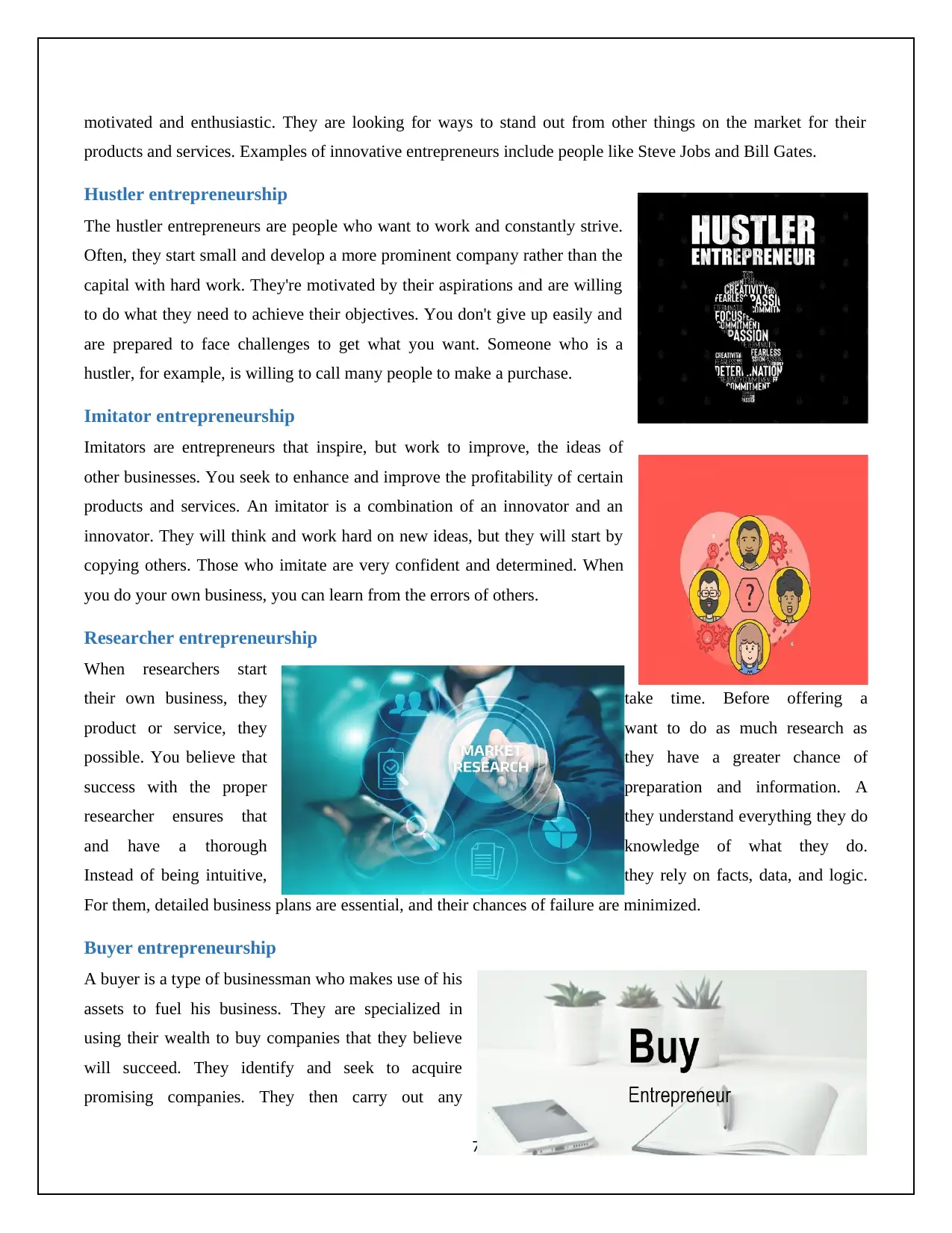
motivated and enthusiastic. They are looking for ways to stand out from other things on the market for their
products and services. Examples of innovative entrepreneurs include people like Steve Jobs and Bill Gates.
Hustler entrepreneurship
The hustler entrepreneurs are people who want to work and constantly strive.
Often, they start small and develop a more prominent company rather than the
capital with hard work. They're motivated by their aspirations and are willing
to do what they need to achieve their objectives. You don't give up easily and
are prepared to face challenges to get what you want. Someone who is a
hustler, for example, is willing to call many people to make a purchase.
Imitator entrepreneurship
Imitators are entrepreneurs that inspire, but work to improve, the ideas of
other businesses. You seek to enhance and improve the profitability of certain
products and services. An imitator is a combination of an innovator and an
innovator. They will think and work hard on new ideas, but they will start by
copying others. Those who imitate are very confident and determined. When
you do your own business, you can learn from the errors of others.
Researcher entrepreneurship
When researchers start
their own business, they take time. Before offering a
product or service, they want to do as much research as
possible. You believe that they have a greater chance of
success with the proper preparation and information. A
researcher ensures that they understand everything they do
and have a thorough knowledge of what they do.
Instead of being intuitive, they rely on facts, data, and logic.
For them, detailed business plans are essential, and their chances of failure are minimized.
Buyer entrepreneurship
A buyer is a type of businessman who makes use of his
assets to fuel his business. They are specialized in
using their wealth to buy companies that they believe
will succeed. They identify and seek to acquire
promising companies. They then carry out any
7
products and services. Examples of innovative entrepreneurs include people like Steve Jobs and Bill Gates.
Hustler entrepreneurship
The hustler entrepreneurs are people who want to work and constantly strive.
Often, they start small and develop a more prominent company rather than the
capital with hard work. They're motivated by their aspirations and are willing
to do what they need to achieve their objectives. You don't give up easily and
are prepared to face challenges to get what you want. Someone who is a
hustler, for example, is willing to call many people to make a purchase.
Imitator entrepreneurship
Imitators are entrepreneurs that inspire, but work to improve, the ideas of
other businesses. You seek to enhance and improve the profitability of certain
products and services. An imitator is a combination of an innovator and an
innovator. They will think and work hard on new ideas, but they will start by
copying others. Those who imitate are very confident and determined. When
you do your own business, you can learn from the errors of others.
Researcher entrepreneurship
When researchers start
their own business, they take time. Before offering a
product or service, they want to do as much research as
possible. You believe that they have a greater chance of
success with the proper preparation and information. A
researcher ensures that they understand everything they do
and have a thorough knowledge of what they do.
Instead of being intuitive, they rely on facts, data, and logic.
For them, detailed business plans are essential, and their chances of failure are minimized.
Buyer entrepreneurship
A buyer is a type of businessman who makes use of his
assets to fuel his business. They are specialized in
using their wealth to buy companies that they believe
will succeed. They identify and seek to acquire
promising companies. They then carry out any
7
Paraphrase This Document
Need a fresh take? Get an instant paraphrase of this document with our AI Paraphraser

management or structural changes that they consider necessary. They aim to expand and expand profits in
businesses they buy. This type of business is less risky, as well-established companies are accepted (2021).
Food Businesses:
Haleem Ghar and Savour Foods
Haleem Ghar and Savour Foods have been chosen as small
business entrepreneurs in this particular report. Since 1987,
when Haleem Ghar was laid out in a small cart, he continued
moving forward with a passion for bringing to the moon the
dream of our ancestor. Hard work is always rewarding, and
efforts are never useless. We learned it in the sparkling eyes of
our grassy words. HaleemGhar mainly aims to offer the
healthiest traditional food to our guests and customers. We have
begun with Haleem, but now we have several other Pakistani
and South Indian specialties to tantalize your taste buds and offer you the best taste in the city. The mission of
Haleem Ghar is to provide healthy, nutritious, delicious food to its citizens because health has not been
compromised. To keep our people in love with food, we choose the best meat under our observation, the best-
unsaturated oil, fresh grasses and legumes, best basmati rice, and fresh aromatic spices. Their objective is to serve
you a delicious, fresh, healthy meal, which will inspire you to come to the Ghar of Haleem Ghar, your own
(Haleem Ghar : A house of unique taste, 2021).
Savour Foods:
Savour Foods is an Islamabad and Rawalpindi
household name. This restaurant renowned for its
delicious pulao kabab is now the identity of the twin
towns. A religious hero and landlord family, Toba
Tek Singh belongs to Haji Mohammad Naeem. In
1988, with the help of his family, he began the first
Savour Foods restaurant. In a small shop near
Rawalpindi, Gordon College, there was a small restaurant. There was a tiny restaurant with a kitchen and a sitting
area with approximately 20 chairs. At that time, things were hard. The shop was opened in a residential area, and
the location was not very busy. Savour Foods have done a lot in the humanitarian field. In times of need, the food
giant helped the country. Savor Foods worked hard for victims of flooding, earthquakes, and internally displaced
persons in Muzaffarabad due to the Zarb e Azab operation (Khan, 2021).
8
businesses they buy. This type of business is less risky, as well-established companies are accepted (2021).
Food Businesses:
Haleem Ghar and Savour Foods
Haleem Ghar and Savour Foods have been chosen as small
business entrepreneurs in this particular report. Since 1987,
when Haleem Ghar was laid out in a small cart, he continued
moving forward with a passion for bringing to the moon the
dream of our ancestor. Hard work is always rewarding, and
efforts are never useless. We learned it in the sparkling eyes of
our grassy words. HaleemGhar mainly aims to offer the
healthiest traditional food to our guests and customers. We have
begun with Haleem, but now we have several other Pakistani
and South Indian specialties to tantalize your taste buds and offer you the best taste in the city. The mission of
Haleem Ghar is to provide healthy, nutritious, delicious food to its citizens because health has not been
compromised. To keep our people in love with food, we choose the best meat under our observation, the best-
unsaturated oil, fresh grasses and legumes, best basmati rice, and fresh aromatic spices. Their objective is to serve
you a delicious, fresh, healthy meal, which will inspire you to come to the Ghar of Haleem Ghar, your own
(Haleem Ghar : A house of unique taste, 2021).
Savour Foods:
Savour Foods is an Islamabad and Rawalpindi
household name. This restaurant renowned for its
delicious pulao kabab is now the identity of the twin
towns. A religious hero and landlord family, Toba
Tek Singh belongs to Haji Mohammad Naeem. In
1988, with the help of his family, he began the first
Savour Foods restaurant. In a small shop near
Rawalpindi, Gordon College, there was a small restaurant. There was a tiny restaurant with a kitchen and a sitting
area with approximately 20 chairs. At that time, things were hard. The shop was opened in a residential area, and
the location was not very busy. Savour Foods have done a lot in the humanitarian field. In times of need, the food
giant helped the country. Savor Foods worked hard for victims of flooding, earthquakes, and internally displaced
persons in Muzaffarabad due to the Zarb e Azab operation (Khan, 2021).
8
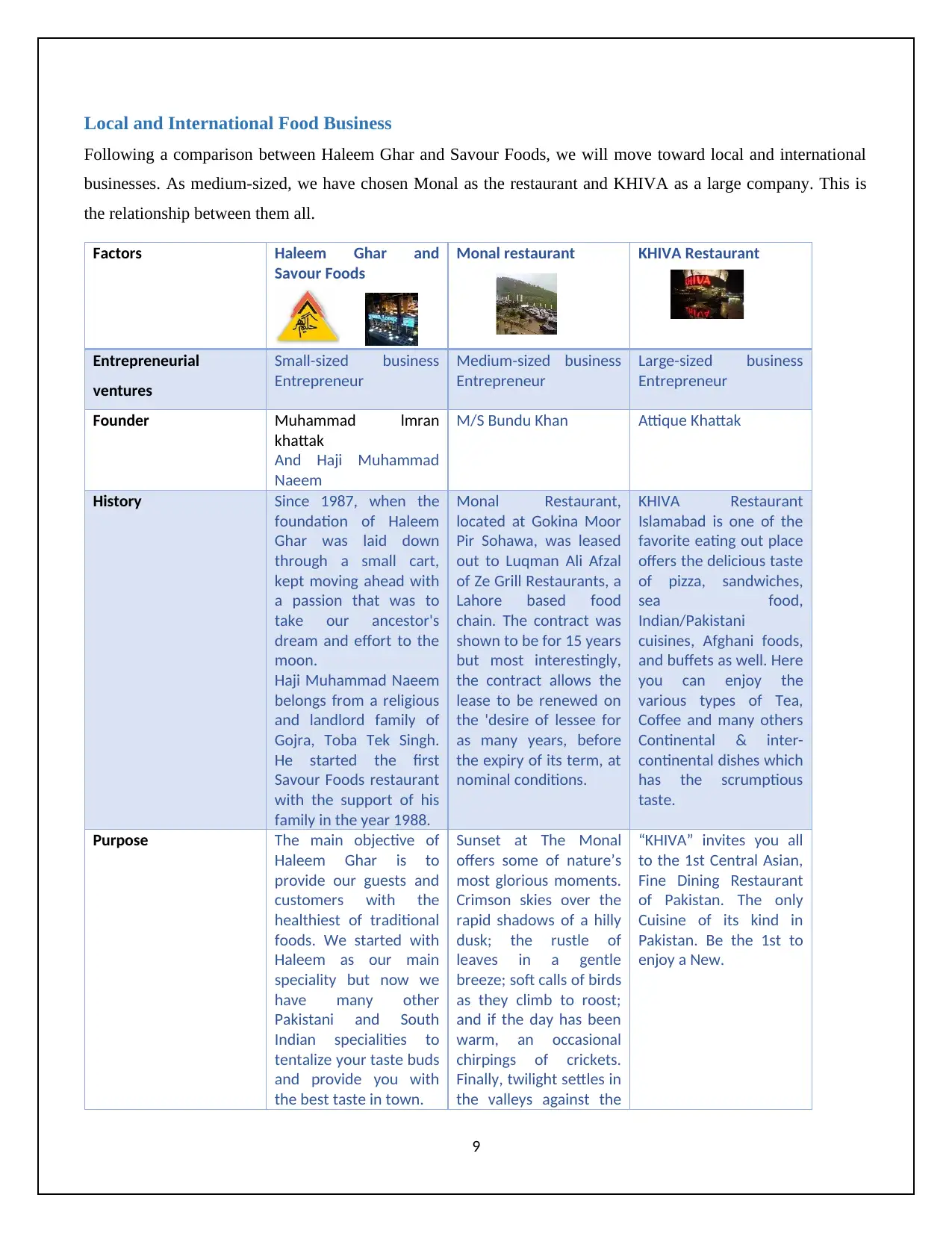
Local and International Food Business
Following a comparison between Haleem Ghar and Savour Foods, we will move toward local and international
businesses. As medium-sized, we have chosen Monal as the restaurant and KHIVA as a large company. This is
the relationship between them all.
Factors Haleem Ghar and
Savour Foods
Monal restaurant KHIVA Restaurant
Entrepreneurial
ventures
Small-sized business
Entrepreneur
Medium-sized business
Entrepreneur
Large-sized business
Entrepreneur
Founder Muhammad lmran
khattak
And Haji Muhammad
Naeem
M/S Bundu Khan Attique Khattak
History Since 1987, when the
foundation of Haleem
Ghar was laid down
through a small cart,
kept moving ahead with
a passion that was to
take our ancestor's
dream and effort to the
moon.
Haji Muhammad Naeem
belongs from a religious
and landlord family of
Gojra, Toba Tek Singh.
He started the first
Savour Foods restaurant
with the support of his
family in the year 1988.
Monal Restaurant,
located at Gokina Moor
Pir Sohawa, was leased
out to Luqman Ali Afzal
of Ze Grill Restaurants, a
Lahore based food
chain. The contract was
shown to be for 15 years
but most interestingly,
the contract allows the
lease to be renewed on
the 'desire of lessee for
as many years, before
the expiry of its term, at
nominal conditions.
KHIVA Restaurant
Islamabad is one of the
favorite eating out place
offers the delicious taste
of pizza, sandwiches,
sea food,
Indian/Pakistani
cuisines, Afghani foods,
and buffets as well. Here
you can enjoy the
various types of Tea,
Coffee and many others
Continental & inter-
continental dishes which
has the scrumptious
taste.
Purpose The main objective of
Haleem Ghar is to
provide our guests and
customers with the
healthiest of traditional
foods. We started with
Haleem as our main
speciality but now we
have many other
Pakistani and South
Indian specialities to
tentalize your taste buds
and provide you with
the best taste in town.
Sunset at The Monal
offers some of nature’s
most glorious moments.
Crimson skies over the
rapid shadows of a hilly
dusk; the rustle of
leaves in a gentle
breeze; soft calls of birds
as they climb to roost;
and if the day has been
warm, an occasional
chirpings of crickets.
Finally, twilight settles in
the valleys against the
“KHIVA” invites you all
to the 1st Central Asian,
Fine Dining Restaurant
of Pakistan. The only
Cuisine of its kind in
Pakistan. Be the 1st to
enjoy a New.
9
Following a comparison between Haleem Ghar and Savour Foods, we will move toward local and international
businesses. As medium-sized, we have chosen Monal as the restaurant and KHIVA as a large company. This is
the relationship between them all.
Factors Haleem Ghar and
Savour Foods
Monal restaurant KHIVA Restaurant
Entrepreneurial
ventures
Small-sized business
Entrepreneur
Medium-sized business
Entrepreneur
Large-sized business
Entrepreneur
Founder Muhammad lmran
khattak
And Haji Muhammad
Naeem
M/S Bundu Khan Attique Khattak
History Since 1987, when the
foundation of Haleem
Ghar was laid down
through a small cart,
kept moving ahead with
a passion that was to
take our ancestor's
dream and effort to the
moon.
Haji Muhammad Naeem
belongs from a religious
and landlord family of
Gojra, Toba Tek Singh.
He started the first
Savour Foods restaurant
with the support of his
family in the year 1988.
Monal Restaurant,
located at Gokina Moor
Pir Sohawa, was leased
out to Luqman Ali Afzal
of Ze Grill Restaurants, a
Lahore based food
chain. The contract was
shown to be for 15 years
but most interestingly,
the contract allows the
lease to be renewed on
the 'desire of lessee for
as many years, before
the expiry of its term, at
nominal conditions.
KHIVA Restaurant
Islamabad is one of the
favorite eating out place
offers the delicious taste
of pizza, sandwiches,
sea food,
Indian/Pakistani
cuisines, Afghani foods,
and buffets as well. Here
you can enjoy the
various types of Tea,
Coffee and many others
Continental & inter-
continental dishes which
has the scrumptious
taste.
Purpose The main objective of
Haleem Ghar is to
provide our guests and
customers with the
healthiest of traditional
foods. We started with
Haleem as our main
speciality but now we
have many other
Pakistani and South
Indian specialities to
tentalize your taste buds
and provide you with
the best taste in town.
Sunset at The Monal
offers some of nature’s
most glorious moments.
Crimson skies over the
rapid shadows of a hilly
dusk; the rustle of
leaves in a gentle
breeze; soft calls of birds
as they climb to roost;
and if the day has been
warm, an occasional
chirpings of crickets.
Finally, twilight settles in
the valleys against the
“KHIVA” invites you all
to the 1st Central Asian,
Fine Dining Restaurant
of Pakistan. The only
Cuisine of its kind in
Pakistan. Be the 1st to
enjoy a New.
9
⊘ This is a preview!⊘
Do you want full access?
Subscribe today to unlock all pages.

Trusted by 1+ million students worldwide
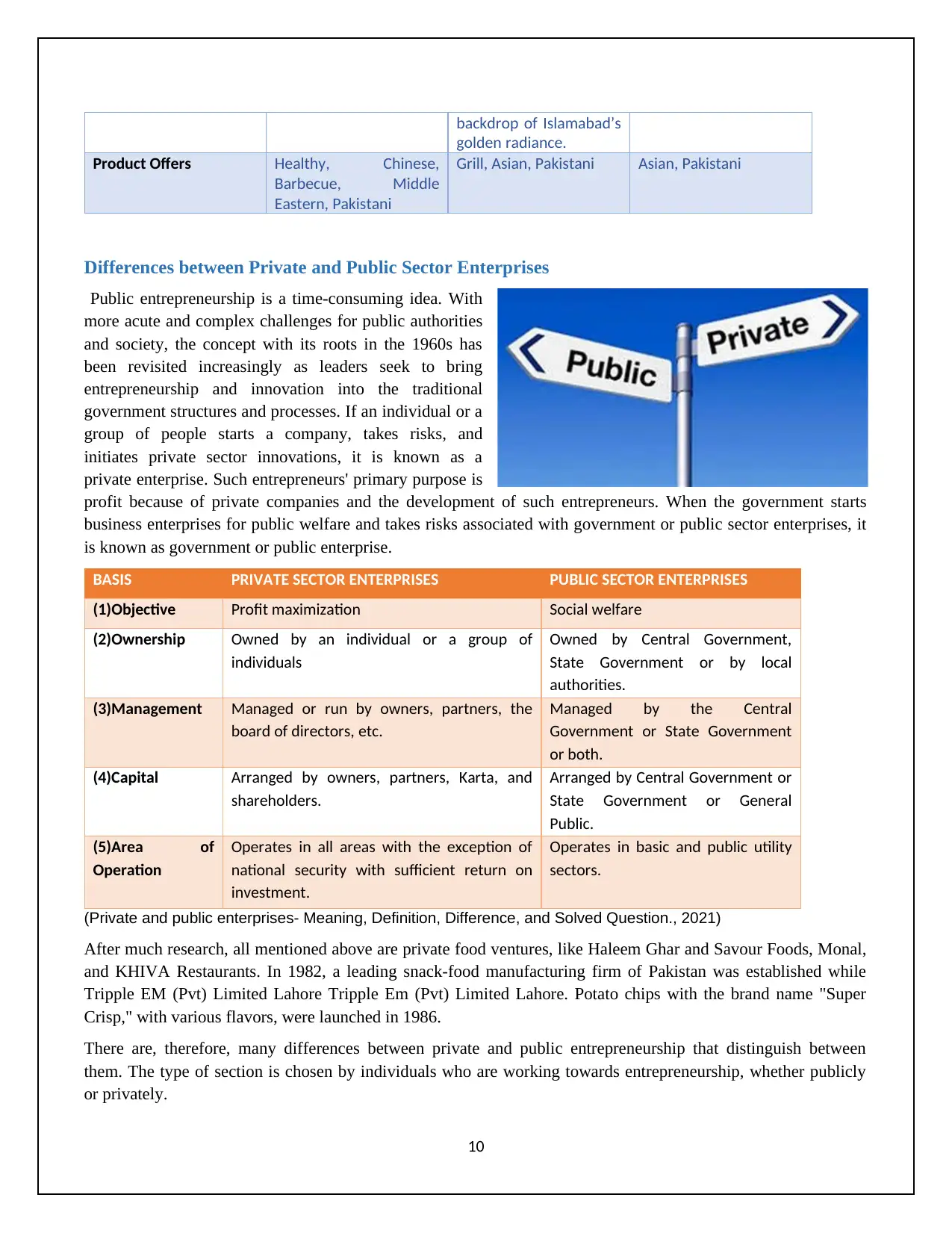
backdrop of Islamabad’s
golden radiance.
Product Offers Healthy, Chinese,
Barbecue, Middle
Eastern, Pakistani
Grill, Asian, Pakistani Asian, Pakistani
Differences between Private and Public Sector Enterprises
Public entrepreneurship is a time-consuming idea. With
more acute and complex challenges for public authorities
and society, the concept with its roots in the 1960s has
been revisited increasingly as leaders seek to bring
entrepreneurship and innovation into the traditional
government structures and processes. If an individual or a
group of people starts a company, takes risks, and
initiates private sector innovations, it is known as a
private enterprise. Such entrepreneurs' primary purpose is
profit because of private companies and the development of such entrepreneurs. When the government starts
business enterprises for public welfare and takes risks associated with government or public sector enterprises, it
is known as government or public enterprise.
BASIS PRIVATE SECTOR ENTERPRISES PUBLIC SECTOR ENTERPRISES
(1)Objective Profit maximization Social welfare
(2)Ownership Owned by an individual or a group of
individuals
Owned by Central Government,
State Government or by local
authorities.
(3)Management Managed or run by owners, partners, the
board of directors, etc.
Managed by the Central
Government or State Government
or both.
(4)Capital Arranged by owners, partners, Karta, and
shareholders.
Arranged by Central Government or
State Government or General
Public.
(5)Area of
Operation
Operates in all areas with the exception of
national security with sufficient return on
investment.
Operates in basic and public utility
sectors.
(Private and public enterprises- Meaning, Definition, Difference, and Solved Question., 2021)
After much research, all mentioned above are private food ventures, like Haleem Ghar and Savour Foods, Monal,
and KHIVA Restaurants. In 1982, a leading snack-food manufacturing firm of Pakistan was established while
Tripple EM (Pvt) Limited Lahore Tripple Em (Pvt) Limited Lahore. Potato chips with the brand name "Super
Crisp," with various flavors, were launched in 1986.
There are, therefore, many differences between private and public entrepreneurship that distinguish between
them. The type of section is chosen by individuals who are working towards entrepreneurship, whether publicly
or privately.
10
golden radiance.
Product Offers Healthy, Chinese,
Barbecue, Middle
Eastern, Pakistani
Grill, Asian, Pakistani Asian, Pakistani
Differences between Private and Public Sector Enterprises
Public entrepreneurship is a time-consuming idea. With
more acute and complex challenges for public authorities
and society, the concept with its roots in the 1960s has
been revisited increasingly as leaders seek to bring
entrepreneurship and innovation into the traditional
government structures and processes. If an individual or a
group of people starts a company, takes risks, and
initiates private sector innovations, it is known as a
private enterprise. Such entrepreneurs' primary purpose is
profit because of private companies and the development of such entrepreneurs. When the government starts
business enterprises for public welfare and takes risks associated with government or public sector enterprises, it
is known as government or public enterprise.
BASIS PRIVATE SECTOR ENTERPRISES PUBLIC SECTOR ENTERPRISES
(1)Objective Profit maximization Social welfare
(2)Ownership Owned by an individual or a group of
individuals
Owned by Central Government,
State Government or by local
authorities.
(3)Management Managed or run by owners, partners, the
board of directors, etc.
Managed by the Central
Government or State Government
or both.
(4)Capital Arranged by owners, partners, Karta, and
shareholders.
Arranged by Central Government or
State Government or General
Public.
(5)Area of
Operation
Operates in all areas with the exception of
national security with sufficient return on
investment.
Operates in basic and public utility
sectors.
(Private and public enterprises- Meaning, Definition, Difference, and Solved Question., 2021)
After much research, all mentioned above are private food ventures, like Haleem Ghar and Savour Foods, Monal,
and KHIVA Restaurants. In 1982, a leading snack-food manufacturing firm of Pakistan was established while
Tripple EM (Pvt) Limited Lahore Tripple Em (Pvt) Limited Lahore. Potato chips with the brand name "Super
Crisp," with various flavors, were launched in 1986.
There are, therefore, many differences between private and public entrepreneurship that distinguish between
them. The type of section is chosen by individuals who are working towards entrepreneurship, whether publicly
or privately.
10
Paraphrase This Document
Need a fresh take? Get an instant paraphrase of this document with our AI Paraphraser

Challenges Faced by New Start-Ups in Pakistan at Governmental and other levels
ENTREPRENEURSHIP and innovation form a building block to
address many of today's emerging economies' economic and social
challenges. Focused on the business sector economy, the same way
technology has brought about success stories in many global
markets can help unlock a nation's potential.
• Pakistan enjoys many of its peers' equal assets. It is
projected to continue to increase in the coming years, at
130 million people under 30 years of age.
• Mobile data connections have multiplied over the last three
years by four, with analysts predicting that their e-
commerce markets will cross the $1 billion mark in 2018.
• The McKinsey City Scope database projects Pakistan to
have an additional 700,000 high and 2.1 million middle-
income households between 2015 and 2025.
• Incubation and government incentives have attracted new venture capitalism to Pakistan across the
nation in an enhanced business environment. However, the country remains a little far away from
achieving its full potential.
• The UAE has a measure of venture capital investing at $40 per capita for the UAE, while Pakistan has
$0.10 – less than its Sri Lankan and Bangladesh regional peers.
• But there's a great deal of chance for the ecosystem. Pakistan can leverage entrepreneurship through
three different boards through robust planning, concerted policies, and private sector initiatives for
public benefit.
• Improved policy and improved infrastructure are two tangible ways governments can help. Starting
single-window companies can save time and money for start-ups, resulting in 17% more registrations in
the subsequent year in Portugal.
• Enabling digital payments or modernizing institutions in the past can improve the capacity for start-ups
to scale complementary infrastructural mechanisms. For example, in Nigeria, investment in a centralized
credit office data hub to improve access for SMEs resulted in a decline in the loan-free ratio while the
number of lenders was rising.
• The private sector can establish financial access routes. According to the World Bank, half of all
Pakistanis have no access to formal financial services. Banks lend only to 188,000 companies of 3.2
million small to medium-sized enterprises in the country.
• The formal financial institutions of Pakistan tend to favor established companies. The resulting funding
gap prevents entrepreneurs from looking at technical feasibility in building commercial or marketing
channels for new products. This offers the national private sector a significant opportunity to fuel
profitable start-ups and generate a higher socio-economic value. As well as local market knowledge,
investors can mitigate their risk by following guiding principles such as insights, driving core value, or
investing in geography or vertical industry along these lines.
Educators can create • Inclusive talent ecosystems. A large pool of talent from Pakis' educational
institutions with around 600,000 graduates each year. But out of 170, the nation ranks 109 on the World
Talent Index (Syed, 2021).
11
ENTREPRENEURSHIP and innovation form a building block to
address many of today's emerging economies' economic and social
challenges. Focused on the business sector economy, the same way
technology has brought about success stories in many global
markets can help unlock a nation's potential.
• Pakistan enjoys many of its peers' equal assets. It is
projected to continue to increase in the coming years, at
130 million people under 30 years of age.
• Mobile data connections have multiplied over the last three
years by four, with analysts predicting that their e-
commerce markets will cross the $1 billion mark in 2018.
• The McKinsey City Scope database projects Pakistan to
have an additional 700,000 high and 2.1 million middle-
income households between 2015 and 2025.
• Incubation and government incentives have attracted new venture capitalism to Pakistan across the
nation in an enhanced business environment. However, the country remains a little far away from
achieving its full potential.
• The UAE has a measure of venture capital investing at $40 per capita for the UAE, while Pakistan has
$0.10 – less than its Sri Lankan and Bangladesh regional peers.
• But there's a great deal of chance for the ecosystem. Pakistan can leverage entrepreneurship through
three different boards through robust planning, concerted policies, and private sector initiatives for
public benefit.
• Improved policy and improved infrastructure are two tangible ways governments can help. Starting
single-window companies can save time and money for start-ups, resulting in 17% more registrations in
the subsequent year in Portugal.
• Enabling digital payments or modernizing institutions in the past can improve the capacity for start-ups
to scale complementary infrastructural mechanisms. For example, in Nigeria, investment in a centralized
credit office data hub to improve access for SMEs resulted in a decline in the loan-free ratio while the
number of lenders was rising.
• The private sector can establish financial access routes. According to the World Bank, half of all
Pakistanis have no access to formal financial services. Banks lend only to 188,000 companies of 3.2
million small to medium-sized enterprises in the country.
• The formal financial institutions of Pakistan tend to favor established companies. The resulting funding
gap prevents entrepreneurs from looking at technical feasibility in building commercial or marketing
channels for new products. This offers the national private sector a significant opportunity to fuel
profitable start-ups and generate a higher socio-economic value. As well as local market knowledge,
investors can mitigate their risk by following guiding principles such as insights, driving core value, or
investing in geography or vertical industry along these lines.
Educators can create • Inclusive talent ecosystems. A large pool of talent from Pakis' educational
institutions with around 600,000 graduates each year. But out of 170, the nation ranks 109 on the World
Talent Index (Syed, 2021).
11
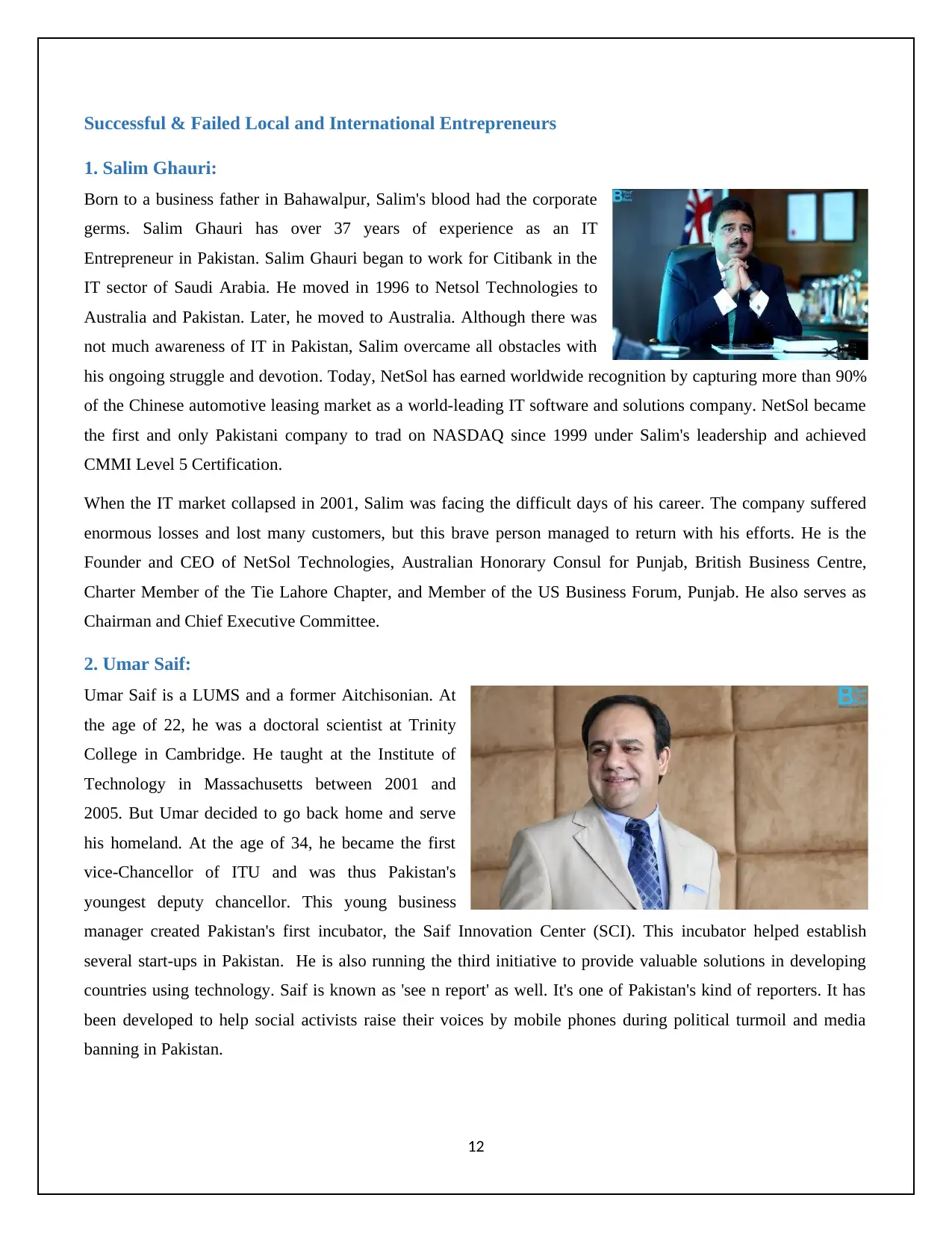
Successful & Failed Local and International Entrepreneurs
1. Salim Ghauri:
Born to a business father in Bahawalpur, Salim's blood had the corporate
germs. Salim Ghauri has over 37 years of experience as an IT
Entrepreneur in Pakistan. Salim Ghauri began to work for Citibank in the
IT sector of Saudi Arabia. He moved in 1996 to Netsol Technologies to
Australia and Pakistan. Later, he moved to Australia. Although there was
not much awareness of IT in Pakistan, Salim overcame all obstacles with
his ongoing struggle and devotion. Today, NetSol has earned worldwide recognition by capturing more than 90%
of the Chinese automotive leasing market as a world-leading IT software and solutions company. NetSol became
the first and only Pakistani company to trad on NASDAQ since 1999 under Salim's leadership and achieved
CMMI Level 5 Certification.
When the IT market collapsed in 2001, Salim was facing the difficult days of his career. The company suffered
enormous losses and lost many customers, but this brave person managed to return with his efforts. He is the
Founder and CEO of NetSol Technologies, Australian Honorary Consul for Punjab, British Business Centre,
Charter Member of the Tie Lahore Chapter, and Member of the US Business Forum, Punjab. He also serves as
Chairman and Chief Executive Committee.
2. Umar Saif:
Umar Saif is a LUMS and a former Aitchisonian. At
the age of 22, he was a doctoral scientist at Trinity
College in Cambridge. He taught at the Institute of
Technology in Massachusetts between 2001 and
2005. But Umar decided to go back home and serve
his homeland. At the age of 34, he became the first
vice-Chancellor of ITU and was thus Pakistan's
youngest deputy chancellor. This young business
manager created Pakistan's first incubator, the Saif Innovation Center (SCI). This incubator helped establish
several start-ups in Pakistan. He is also running the third initiative to provide valuable solutions in developing
countries using technology. Saif is known as 'see n report' as well. It's one of Pakistan's kind of reporters. It has
been developed to help social activists raise their voices by mobile phones during political turmoil and media
banning in Pakistan.
12
1. Salim Ghauri:
Born to a business father in Bahawalpur, Salim's blood had the corporate
germs. Salim Ghauri has over 37 years of experience as an IT
Entrepreneur in Pakistan. Salim Ghauri began to work for Citibank in the
IT sector of Saudi Arabia. He moved in 1996 to Netsol Technologies to
Australia and Pakistan. Later, he moved to Australia. Although there was
not much awareness of IT in Pakistan, Salim overcame all obstacles with
his ongoing struggle and devotion. Today, NetSol has earned worldwide recognition by capturing more than 90%
of the Chinese automotive leasing market as a world-leading IT software and solutions company. NetSol became
the first and only Pakistani company to trad on NASDAQ since 1999 under Salim's leadership and achieved
CMMI Level 5 Certification.
When the IT market collapsed in 2001, Salim was facing the difficult days of his career. The company suffered
enormous losses and lost many customers, but this brave person managed to return with his efforts. He is the
Founder and CEO of NetSol Technologies, Australian Honorary Consul for Punjab, British Business Centre,
Charter Member of the Tie Lahore Chapter, and Member of the US Business Forum, Punjab. He also serves as
Chairman and Chief Executive Committee.
2. Umar Saif:
Umar Saif is a LUMS and a former Aitchisonian. At
the age of 22, he was a doctoral scientist at Trinity
College in Cambridge. He taught at the Institute of
Technology in Massachusetts between 2001 and
2005. But Umar decided to go back home and serve
his homeland. At the age of 34, he became the first
vice-Chancellor of ITU and was thus Pakistan's
youngest deputy chancellor. This young business
manager created Pakistan's first incubator, the Saif Innovation Center (SCI). This incubator helped establish
several start-ups in Pakistan. He is also running the third initiative to provide valuable solutions in developing
countries using technology. Saif is known as 'see n report' as well. It's one of Pakistan's kind of reporters. It has
been developed to help social activists raise their voices by mobile phones during political turmoil and media
banning in Pakistan.
12
⊘ This is a preview!⊘
Do you want full access?
Subscribe today to unlock all pages.

Trusted by 1+ million students worldwide
1 out of 30
Related Documents
Your All-in-One AI-Powered Toolkit for Academic Success.
+13062052269
info@desklib.com
Available 24*7 on WhatsApp / Email
![[object Object]](/_next/static/media/star-bottom.7253800d.svg)
Unlock your academic potential
Copyright © 2020–2025 A2Z Services. All Rights Reserved. Developed and managed by ZUCOL.




